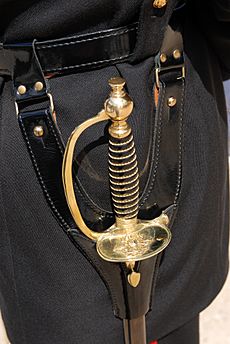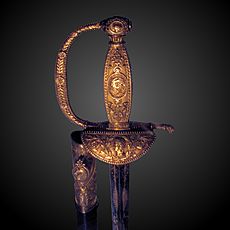Small sword facts for kids
The small sword was a light, one-handed sword mostly used for thrusting. It developed from the longer, heavier rapier sword. Small swords were most popular in the 1700s. During this time, many civilians and military officers who wanted to be seen as a gentleman would wear a small sword every day.
The blade of a small sword was usually about 0.6 to 0.85 meters (2 to 3 feet) long, though some could be over 1 meter (3.3 feet). It typically ended in a sharp point and often did not have a sharp cutting edge. The blade was usually triangular when you looked at its cross-section. This shape made it lighter.
It is believed that the small sword first appeared in France and quickly became popular across Europe. It was the direct ancestor of the French dueling sword, which later led to the modern épée used in fencing. The way people used the small sword developed into the techniques of classical French fencing. Small swords were mainly used for duels, which were formal fights between two people.
In the military, small swords were used by infantry officers as a standard sidearm. Even today, in some military branches, officers still carry them, but only for ceremonies and formal events. Officers sometimes carried swords in combat during World War I and even in World War II. The U.S. Army manual from 1913 even taught soldiers how to defend against someone using a small sword.
Bayonets from that time, like the British Pattern 1907 bayonet, were quite long, often 20 inches or more. A small sword could be carried in a similar way and would not look out of place.
What Did the Hilt Look Like?
The hilt is the handle and guard of a sword. The small sword's guard was often shaped like a "shell," sometimes with two parts that looked like clam shells. These shells were often replaced with a simple curved oval disk, which was still called the coquille (shell) in French.
In later foils (a type of fencing sword), the shell-shaped guard became a figure-8 shape, and the disk became the modern "bell" guard. But they were still called coquilles. Small swords with these guards usually had other parts from older rapier hilts, like quillons (crossguards), a knuckle-bow (a bar protecting the hand), and a pas d'âne (finger rings). These parts often became smaller and more for decoration than for actual use. However, some weapons, like the Italian foil, kept them useful even into the 1900s.

In the 1800s, simpler small swords with cross-hilts were also made. These were mostly ceremonial weapons, meaning they were used for special events and looked like older types of swords. An example is the Model 1840 Army Noncommissioned Officers' Sword, which the United States Army still uses for ceremonies. As wearing swords became less common and the small sword changed into the dueling sword, the older hilts were replaced by simpler grips like the French grip and Italian grip.
How Was the Small Sword Used?
Small swords were used by the military, where they showed an officer's rank more than being a combat weapon. They were also very popular for dueling. The small sword was most widely used in the 1700s. At that time, it was very fashionable for noble people. People would say, "no gentleman was dressed without his sword."
Small swords were used for dueling even until the mid-1900s. For example, in a duel in Paris in 1967, two men named Gaston Defferre and René Ribière used larger, heavier versions of the épée. These swords had small sword-style blades instead of the flexible blades used in modern sport fencing. The U.S. manual from 1861, "The Militiaman's Manual," also covered how infantry soldiers could use the small sword.
Today, the small sword is often part of special uniforms, like the court uniform and dress in the United Kingdom. In Germany, a version called "Trauerdegen" ("mourning épée") is still used by the Reitendiener (a type of attendant) in the city of Hamburg.
See also
In Spanish: Espadín para niños



